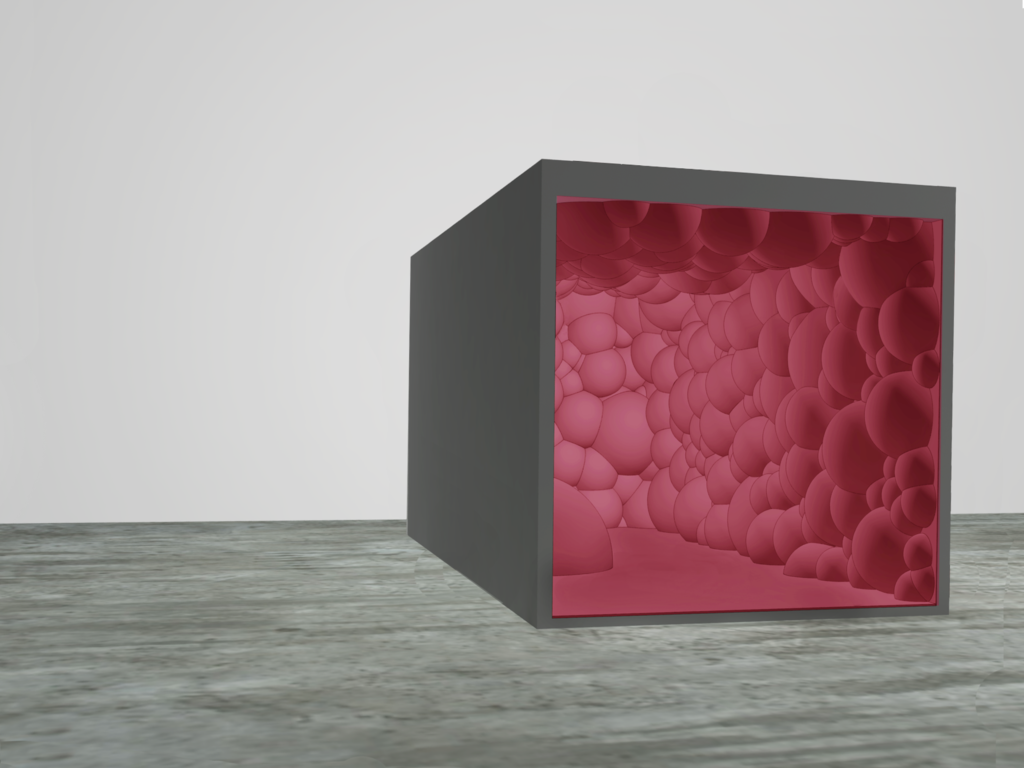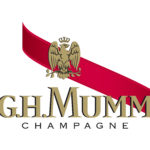Into the Curve
Natalie Clark
10 September – 26 November 2018
Opening night reception with + publication launch + live performance: 1o September, 19:30 – 21:30
Performance art: Nogi Sumiko | のぎすみこ, 20:30
Champagne reception by GH Mumm

© Natalie Clark, 2018. Into the Curve, concept illustration. Rendering: Jakub Galczynski. The Container, Tokyo.
|
ナタリー・ジェーン・クラークは、正式な芸術家養成教育をバックグラウンドに持つ、イギリス系アメリカ人アーティスト・デザイナー・教育者である。現在の活躍範囲は、米国西部とスペイン・バルセロナのスタジオの二つに分かれている。活躍内容は、オリジナルの彫刻・アートコンサルティング・キュレーション・デザインを含む。イギリスのブライトン大学から彫刻専攻の美術学士を獲得した後、全額奨学金で渡米し、シカゴ美術館附属芸術大学から芸術学修士を獲得した。ウィスコンシン州コーラー・ファクトリーで、アーティスト・イン・レジデンスとして正式な教練を積み、テキサス州及びワイオミング州の大学で教授職に就いた。9/11を記念した応募作品は、デザインコンペにおいてファイナリストとして選択され、ニューヨークで展示された。作品は、米国・カナダ・ヨーロッパ各地で、公私問わず、様々なコレクションで展示されている。 __________________ フェミニズムアートは常に批判にさらされてきた。第一には、その認証の問題がある。果たして性差の事実を表現した芸術作品に普遍性はあるのであろうか、と問われるからだ。社会的にはエリート主義・インテリ主義・白人中心的であると一般社会から拒絶されてきた。他方、多くの女性芸術家は、60年代の社会運動やフェミニズム運動の波に乗って、女性の芸術家としての表現と同時に、彼女たちの作品が表すもう一つの事実、すなわち、女性の事実に対する何百年に及んだ被害を正すよう、公平な代償を毅然と求めてきた。 ただし、女性芸術家の一部では、一般社会を深く考慮する者もいる。中には政治的に傾斜している者も、していない者もいる。60年代と70年代では、自らの身体を芸術作品の中心的要素として活用した女性パフォーマンスアーティストの増加を見た。しかし、女性によるアートは、社会的には例えば、人種的マイノリティやLGBTの芸術家に比べて、勢いを持たなかった。マイノリティによる芸術作品を避けることは、女性を避けることよりも政治的に適切(ポリティカリー・コレクト)でなかったからである。 数年前、私がナタリー・クラークと出会った時、彼女は自分の彫刻を何点か紹介してくれた。私は、彼女の作品が持つ、シャープで容赦なく、かつデリケートなシンプル性と高い洗練性を帯びた、男根やマスキュリニティーが内含された、フェミニティーの強い存在感に印象づけられた。例えば、Crystalline Spires, Faceted Gems (邦題:クリスタルの尖塔と面取りされた宝石)では、面と色・フォームと表情・自然と文化の統合が表現されており、彼女のグローバルな流動性と長年の経験・旅・文化が彼女へ与えた影響が反映されている。彼女はやはり、強くて洗練された女性であり、彼女の作品も同様だ。しかし、私は最近一年半、彼女の態度と作品に変化を感じるようにもなった。シャープだった角は曲線に変わり、外向的な視点は内向的なものへと変わった。彼女の作品は、女性として、また、一個人としての変化を反映し、自己をまるでスピリチュアルに讃えるような、パーソナルなものに進化してきた。 キュレーター仲間と友人として、私は、クラークのそのような変化に魅了され、アーティストとしての自分の進化をコンテナーで展示しないか、と彼女へ持ちかけた。彼女は通常、屋外展示用の作品や彫刻を作っているため、面白いチョイスだと私も考えた。普段は広大な屋外空間から見いだしているインスピレーションや、新たに培った美的感覚を用い、コンテナーの半分というわずかなスペースの中で、どのように彼女が自分のクリエイティビティを包含するか気になった。「男性社会」だと評されている日本において、如何にビジュアルで社会的な影響を生むかは重大な問いであった。 さて、この展示について私たちが議論し始めたのは一年以上前のことである。アイディアやメモを交換したりする過程や、クラークが我々の対話を通じて得た個人的変化や気付きによって、展示物はしょっちゅう変化し続けた。しかし、最初から明らかだったことは二つあった。まず、展示作品が、女性らしさとフェミニティーを讃え、物理的かつ心理的に、人を引きつける必要性があり、また、身体的体験をもたらす必要性があった。 彼女が、見物者が中に入って女性の身体を探ることのできる、和紙で作られた巨大なヴァギナのスケッチを何点か送ってくれた時には、「ついにひらめいたのか」と私は思った。しかし、フェミニティーよりも生物学的な視点が重視されてしまうのではないか、女性運動とクラークの美しくかつ絶妙に知的な創造性を、無意識に損なってしまうのではないかと、懸念もあった。したがって、この作品を実現させる可能性として、ラテックスから膨張式物質など、様々な行程、資材、視角を議論し続けた。 その傍らでは、#MeToo運動が世界中の関心と注目を引きつけるようになり、私とクラークを二人揃ってより一層内省的にさせた。運動の重大性は増したが、日本でのリアクションは、ネットのニュースサイトに取り上げられるまで大手メディアの殆どが無視するなど、様々であった。世間の注目を集まり、加害者の懲戒へ繋がったケースもあったが、被害者の一部は、ソーシャルメディアで激しい攻撃を浴びたりもした。このようなこともあり、クラークの展示を、ここ日本で、このタイミングで実現させる必要性が益々固まった。 今回、コンテナーで展示されるクラークの作品展、Into the Curve(邦題:曲線の中へ)は、見物者が中へ入ることもできる、包み込むような環境を作り出している。その空間は、フェミニティーのトンネルを再現するかのように、壁張りされた真っ赤な織物によって充満されている。丸くて曲線的な形は、ある者にとって、女性の乳やヒップを思い起こさせ、よりセクシュアルな者にとっては、ヴァギナやその陰門を思い起こさせるかもしれない。真っ赤な布のチョイスは、内蔵の中に閉じ込められたような感覚をほのめかし、エンパワーメントやパッションを伝えるのかもしれない。展示品は総じて、かなり抽象的であり、多様な解釈を可能にしているが、その感覚的インパクトは、精密で的確であろう。クラークは次のように言う。「私はフェミニンなヌード・フォームへの没入状態を作りあげている。波打つように滑らかに壁張りされた織物は、ボタンが深く縫い付けられ、曲線美もあり、比喩的な雰囲気を醸している。女性やジェンダーレスの人の尻・乳・腹を思い浮かべてもらいたい。更に言えば柔らかくてしなやかな人間の形状を。対話的・没入的・普遍的で、真っ赤でディープな色調に満たされている。私は、色の影響が、私自身に刻印していることに対して反応しているのだ。すなわち、要素的・感情的・普遍的な色の象徴的使用である。」 家具の装飾に良く見られる壁張り方法を敢えて選んで作品を作ったことは、偶然のことではない。当作品は、家庭と伝統と関連付けられており、歓迎的で温かい空間を作っている。見物者は、作品に包み込まれ、母胎のように柔らかいその表面に寄りかかったり、触ることができる。クラークは憚ることなく、母性・育生・妊性を女性エンパワーメントと自尊心と結びつけ、安心と快適さを喚起させる空間を作ったのである。自分の食べ物は自分で栽培するという彼女の関心と、種から花まできちんと育てるとい作られた彼女の広い庭園は、今回コンテナーの展示を実現させること、彼女の温かいフェミニンなアーティストとしての進化にとって、肝心な要素である。 クラークの絶え間ない渡航やアート・デザイン・クラフトに対する熱意は、世界中のアーティストとのコラボレーションを可能にしている。本展の実現に力を貸してくださったイギリス・フェニックス大学のマシュー・カードウェルさん、女性の美しい写真を提供してくださった若きスペイン人写真家のマティー・シェヴェリエールさんにはお礼を述べたい。シェヴェリエールさんによって撮影された写真は、クラークのスタジオと庭園で撮影されたもので、本カタログにも含まれている。最後に、マム・シャンペーンの協賛に感謝申し上げたい。 |
Natalie Jane Clark is a British-American classically-trained artist, designer and educator. Her current practice is split between studios in the American West and Barcelona, Spain, and includes original sculptures, art consulting, curation, and design. Clark obtained a Bachelor’s Degree in Fine Arts, majoring in sculpture, from Brighton University in England. She came to the United States on a full-merit scholarship, and attained her Masters in Fine Arts from the Art Institute of Chicago. She followed her formal training with an Artist-in-Industry Residency at the Kohler factory in Wisconsin and has taught at university level in Texas and Wyoming. Clark’s 9/11 Memorial submission was a finalist in the design competition and has been exhibited in New York. Her works are in both private and public collections within the USA, Canada, and Europe.
__________________ Feminist art never really stood a fair chance. Critically, it poses a great problem of authentication; how can a piece of art, presenting a gendered truth, still be perceived as universal? While socially, it has been shunned by the mainstream, being claimed as too elitist, intellectualist, and white. Yet women artists, carried by the waves of social activism and the feminist movement of the sixties, still rightfully demand a just indemnity for centuries of damages done to the representation of females as artists, and to the works that seek to present another truth—women’s truth. Some female artists do filter in, though, to the mainstream—some are more politically inclined and some are less. The sixties and seventies saw also the rise of a number of female performance artists, using their body as a central element in their artworks, but socially, these works gained less traction than the works of racial minorities or LGBT, for example. It is less politically correct to eschew the works of minorities. When I met Natalie Clark a few years ago, she shared with me some her of sculptural works. I was impressed by their strong presence, phallic and masculine in their femininity—sharp and unforgiving—but also delicate in their simplicity and high polish. Her series of sculptures Crystalline Spires, Faceted Gems, for example, represents an integration of nature and culture, of facets and colors, form and emotion, and make reference to her global mobility and impressions those experiences, journeys, and cultures left on her. She is a strong refined woman, and so is her art. Over the last year and a half, though, I have noticed a change, in her attitude and in the works she produces: sharp corners turned into curves, and outwardly perception turned inwards. Her work has evolved to be more personal, tuning into her own changes as a person and a woman, almost in a spiritual way, a celebration of the self. I was intrigued by those changes, as a curator and as a friend, and invited Clark to produce an installation at The Container that explores her evolvement as an artist. Clark, who usually produces outdoor installations and sculptures, seemed like an interesting choice. I was curious to see how she can contain her creativity, that usually finds inspiration from vast open-air settings, in the gallery’s half-sized container enclosure, and by her newly found aesthetics. How can we make a visual and social impact, especially in Japan, in a ‘men’s world’? We started to discuss her exhibition more than a year ago, exchanging ideas and notes, and the installation kept changing, along with the personal changes and understandings that Clark gained along the way. Two things were clear from the get-go, though—it is ought to be a piece that celebrates womanhood and femininity, and it needs to be physically and psychologically engaging—a bodily experience. Initially, I thought that she cracked it when she sent me some drawings of a life-sized vagina, made of washi paper, where spectators would be able to walk into it, navigating inside a woman’s body. However, we were both concerned that such an installation puts more emphasis on mere biology than representing the notion of femininity, and that perhaps, unintentionally, we would be doing a injustice to the cause, and possibly, to Clark’s beautiful, intellectually subtle, way of working. So we kept discussing various processes, materials, and visuals, from latex to inflatables, as possibilities to fabricate the piece. Meanwhile, the #MeToo movement caught the attention and interest of the public worldwide, and it made both Clark and me more reflective. It became more important. The reaction to the movement in Japan was very mixed, with much of mainstream press choosing to ignore it, until it was, eventually, picked up by online news sites. Although some high profile cases came to light and resignations followed, some of the victims suffered an onslaught attack on social media. Those reactions crystallized that such an exhibition is particularly important to do here and now. Natalie Clark’s resulting installation at The Container, Into the Curve, creates an immersive environment spectators can walk into. The entire space is saturated with madder red textiles, assembled with upholstery techniques, to create a tunnel of femininity. The shapes, round and curved, may recall female breasts or hips, or to the more sexually inclined, a vulva or a vagina. To others, the choice of the red fabric perhaps alludes to being trapped in internal organs, but also communicates empowerment and passion. Overall, the installation is very abstract and open to a variety of personal interpretations, but the sensory impact is exact and precise. To quote Clark, “I’m creating an immersion of the feminine nude form, an undulating upholstered interior installation, deep buttoned, curvaceous, figurative. Think bums, boobs, bellies of no specific gender. Soft and pliable, a human landscape; interactive, immersive, and universal—saturated in deep hues of madder red. I am responding to the influence of color imprinted on me. The elemental, emotional and universal symbolic use of color.” The choice of upholstery techniques to fabricate the piece was not coincidental. The craft is associated with domesticity and tradition, and creates an inviting homely environment. Spectators are encased in the installation, and can touch or lean against the soft surfaces, like a womb. Clark has created an environment that induces comfort and safety, making no apologies for linking maternality, nurture and fertility with women’s empowerment and self-pride. Her keen interest in growing her own food and extensive gardens of flowers, nurturing from seed to product is a pivotal element in her installation at The Container, and her evolution as a nurturing feminine artist. Clark’s incessant travels and enthusiasm for art, design and craft, enable her to collaborate with artists worldwide. We are terribly grateful for the help of Matthew Caldwell, of Phoenix Upholstery, in the UK, to realize this piece and make it possible, and for the beautiful photographs of women by the young Spanish photographer Maty Chevriere, which were taken in Clark’s studio and gardens, and are included in the catalogue. Lastly, The Container is also delighted by and appreciative of the support of G.H. Mumm for this exhibition. |
